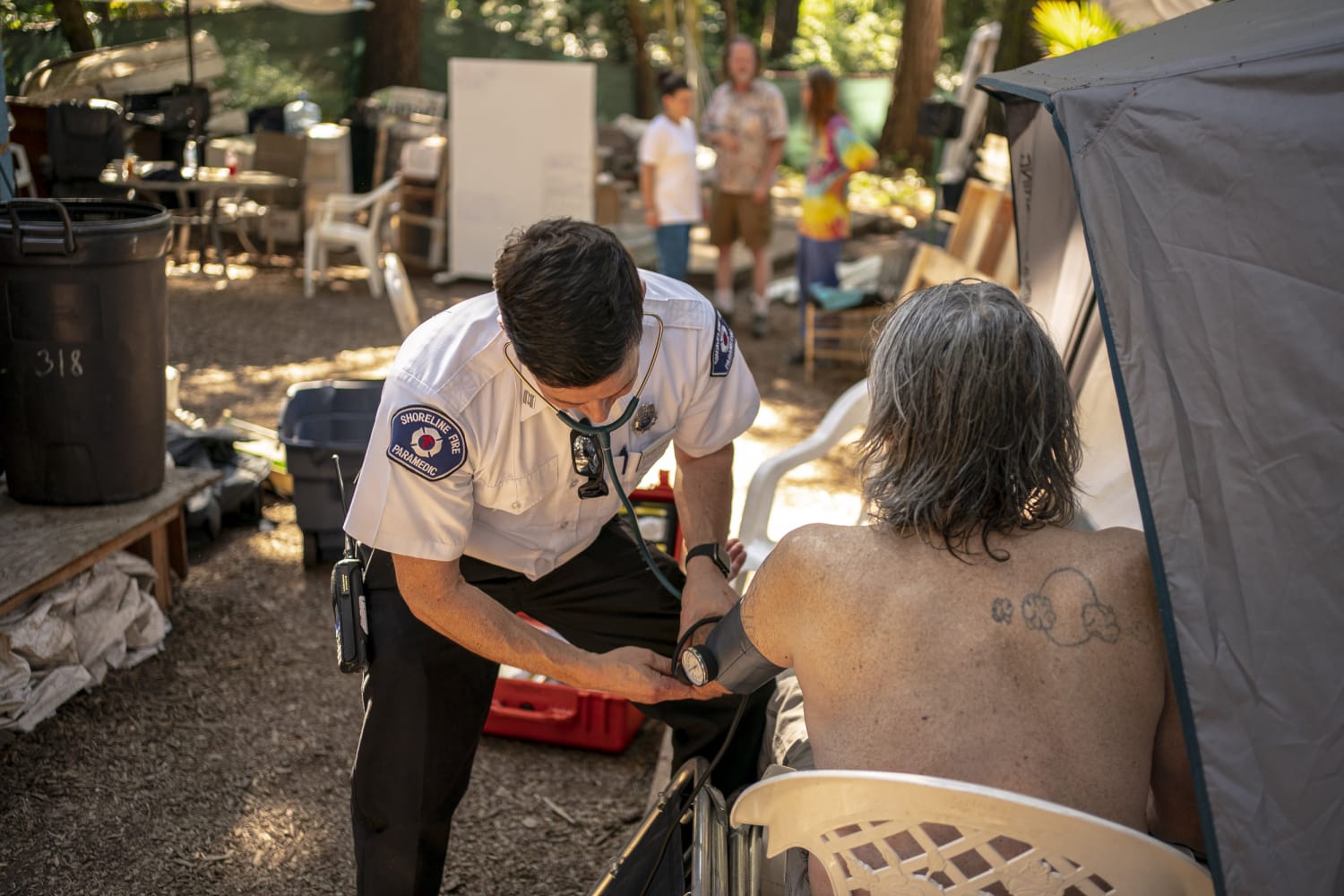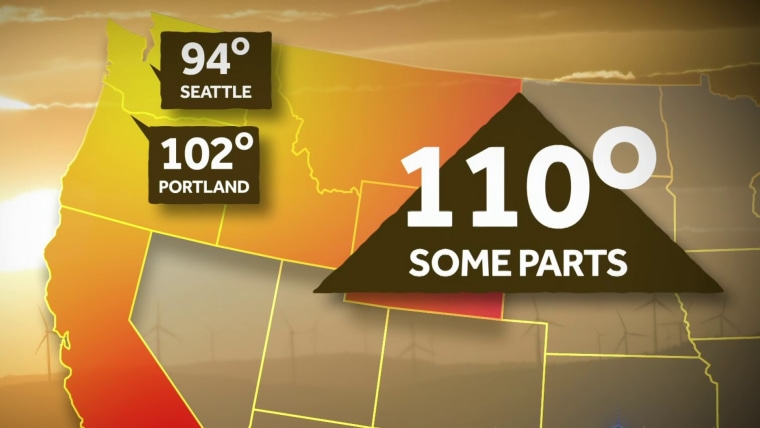Extreme heat is suspected in at least four deaths in Oregon as the Pacific Northwest continues to bake Friday in a prolonged heat wave, which has exceeded triple digits in many parts of the region.
The Multnomah County medical examiner is investigating whether heat played a role in three deaths in Portland, according to an agency news release. A fourth possible heat-related death was reported in Umatilla County, on the state’s east side, according to Oregon Public Broadcasting.
Portland reached 102 degrees Fahrenheit on Tuesday, setting a new daily record for July 26. Seattle broke its daily record the same day, rising to 94 degrees. Parts of the inland Northwest, which are more accustomed to searing temperatures, neared 110 degrees at times this week.
The heat wave, which forecasters expect to continue into the weekend, was a reminder of the risks that extreme heat poses in the Pacific Northwest, where people west of the Cascade mountains are poorly adapted for extreme heat and natural systems are vulnerable to soaring temperatures.
While damaging, the impacts of the heat wave remained less significant through Friday compared to the heat dome last year, which stunned the Pacific Northwest as temperatures in some places soared five degrees or more past all-time highs. Seattle temperatures crested at 108 degrees, and Portland hit 116. Hundreds died.
Temperatures this year were not expected to reach such dangerous levels, and local governments had spent the cooler months preparing for impacts — with some evidence that the new planning, while incomplete, was paying off.
June 2021’s heat wave was “virtually impossible,” according to some experts, if not for the impacts of climate change. Searing temperatures crumbled streets in Seattle, caused baby birds to jump to their deaths across the region, killed millions of sea creatures along the coastline and cost Washington state about one-fifth of its cherry crop.
This year, cool spring weather, which helped build a hearty mountain snowpack, buffered some of the recent heat, and officials said they were better prepared after hard lessons last year.
“From my experience, the heart dome — we saw it coming, but we didn’t have quite enough coordination to really get ahead of it,” said Rad Cunningham, a senior epidemiologist at the Washington State Department of Health, of the 2021 heat wave. “We’ve done our work to improve our systems.”
The 2021 heat wave served as a wake-up call for the Northwest, where many households don’t have air conditioning. Many cities, including Seattle, didn’t have specific action plans for heat waves.
The city now has a draft plan under development, according to the radio station KUOW. King County, which includes Seattle and its suburbs, is developing a heat mitigation strategy. Portland started a program to provide cooling heat-pump devices for low-income residents.
Washington state’s workplace safety regulator rolled out new emergency heat rules in an attempt to better protect outdoor workers. Oregon in May introduced new permanent rules.
This year, state and local public health agencies fired off a flurry of heat messages many days before the temperatures spiked.
“You could see from our social media this year, we got out with heat messaging well ahead of this event,” Cunningham said. “We were scrambling to catch up during the heat dome last year.”
Last summer, 157 deaths from heat-related illnesses were reported in Washington state; most were recorded during the three-day heat wave that June. Nearly 100 deaths were reported in Oregon during the heat wave. The true toll is likely higher, as heat often exacerbates concerns like heart or kidney conditions but isn’t implicated directly in official death data.
The 2021 heat dome wrought disastrous environmental effects. Shellfish were exposed by low tides that came during the hottest times of the day, leaving the creatures to steam onshore to their deaths. Some fish die-offs were reported in overheated streams. Intense temperatures sunburned cherries, forcing some growers to abandon their crop altogether.
This year’s heat wave was primed for less dire impacts.
Coastal temperatures remained more modest, and the timing of tides offered more protection for shellfish during the heat of the day. The above-average snowpack and a cool spring meant the Columbia River was flowing with cool temperatures preferred by salmon, trout and other species.
“It’s a degree cooler compared to the five-year average this time of year,” said Ben Anderson, a spokespereson for Washington’s fish and wildlife agency. “The flows are looking pretty good.”
Many cherry crops have already been picked, and the heat wave missed disrupting the season, said Jon DeVaney, president of the Washington State Tree Fruit Association. Growers have grown accustomed to shifting picking hours earlier in the day when necessary, DeVaney said.
Gowers last year scrambled to buy headlamps and lighting so workers could pick overnight in orchards, when the fruit is less likely to be damaged and when workers are at less risk. It’s an investment that could pay off in the future.
“Last year, they had to invest in all the lighting infrastructure and work through the details of being able to do that,” said Lee Kalcsits, an associate professor of tree fruit physiology at Washington State University. “Everyone shifted toward moving towards night probably faster than they would have if the heat dome hadn’t happened.”
As the climate warms, an increasing number of cherry growers are also investing in shade cloth, which filters out between 10% and 30% of overhead sunlight on their crops, Kalcsits added. It helps them save water and prevent their fruit from becoming sunburned when temperatures spike.
Health care workers remained wary of the weekend, with the forecast calling for extreme temperatures through Sunday in the inland Northwest.
In Washington state, 242 emergency department visits for heat-related illness had been reported to the state Department of Health from Monday through Friday morning.
“During the heat dome, we had as many as 200 in a single day,” Cunningham said. But “we’re not done with this one yet.”
Heat’s effects can accumulate over time, especially if people can’t cool their bodies down sufficiently at night, said Dr. Antonio Germann, a physician with the Yakima Valley Farm Workers Clinic.
Germann said about 50% of his patients are migrant farmworkers, including some who worked outside during the day and were living in housing that lacked air conditioning.
”The longer duration of these heat waves makes it more complex and risky for them,” Germann said.
When Germann came to his clinic in Oregon’s Willamette Valley about a decade ago, he didn’t think much about the impacts of heat. He now sees its imprint on many patients.
“Asthma, heart disease, kidney disease and things of that nature, these are related, and these are the consequences of a climate that is changing,” Germann said.
Source: | This article originally belongs to Nbcnews.com












